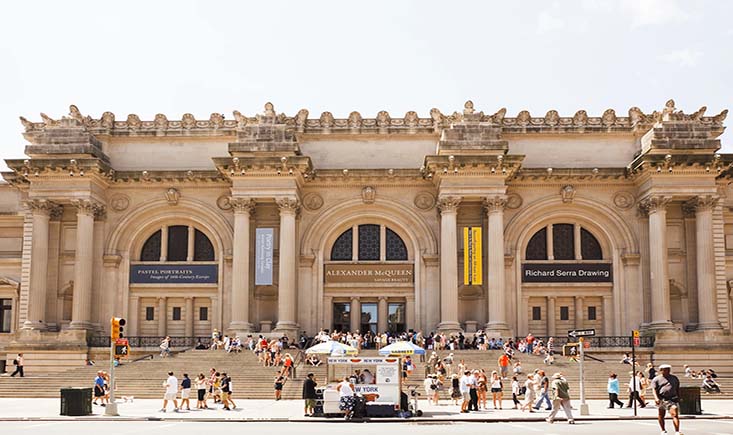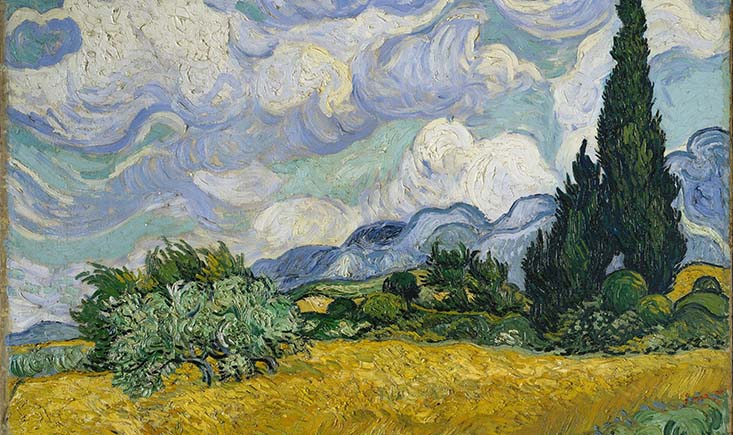
The Metropolitan Museum of Art: A Cultural Gem in the Heart of New York
Book Tours & Attractions . Destinations . Sustainable TravelThe Metropolitan Museum of Art, fondly known as “The Met,” is a true cultural treasure nestled in the heart of New York City. With its expansive collection spanning across time and geography, it’s a place where art, history, and human creativity converge in breathtaking harmony. I’ll recount my recent visit to The Met, sharing my personal favorites among the myriad of masterpieces and recommending four additional artworks for fellow art enthusiasts. I’ll delve into comprehensive descriptions and insights about seven specific pieces, including services, pros and cons, the museum’s exact location, directions, discounts, ticket prices, recommendation ratings, and booking options. Join me on this captivating journey through The Met, where each step unveils a new facet of human expression.
About The Met:
The Metropolitan Museum of Art, founded in 1870, stands as one of the largest and most prestigious art museums globally, with a renowned collection that spans over two million square feet. Situated at 1000 Fifth Avenue, New York, NY 10028, the museum houses a remarkable collection of over two million works of art, ranging from ancient Egyptian relics to contemporary masterpieces.
My Favorites:
1. Vincent van Gogh – “Wheat Field with Cypresses”

- Description: This vibrant oil painting by Vincent van Gogh portrays a swirling, golden wheat field beneath a turbulent blue sky. The cypress trees in the background add an element of serenity to the composition.”Wheat Field with Cypresses” is a testament to Vincent van Gogh’s genius, painted in 1889 during his residency at Saint-Paul-de-Mausole in Saint-Rémy-de-Provence, France. This post-impressionist masterpiece captures the tumultuous beauty of a wheat field beneath a swirling, vibrant sky, with majestic cypress trees gracing the foreground.
- Impressions: Van Gogh’s adept use of color and texture imparts a palpable sense of movement and emotion to the scene. It’s a masterpiece that poignantly reflects the artist’s inner turmoil and deep connection to nature.To stand before van Gogh’s “Wheat Field with Cypresses” is to commune with raw emotion and artistic brilliance. The bold, frenetic brushstrokes evoke a palpable sense of serenity and turbulence, immersing the viewer in a world of vivid color and intricate detail. It feels as though one can almost hear the wind rustling through the wheat and the cypresses whispering secrets in the breeze. The painting encapsulates van Gogh’s passion and inner turmoil, now eternally preserved on canvas.
- Significance:This masterpiece not only showcases van Gogh’s artistic prowess but also serves as a testament to his profound connection with the natural world. It offers a window into the artist’s fervent desire to convey the depths of human experience through his art.
- Recommendation Score: 9.5/10 – A quintessential van Gogh masterpiece that should not be missed.
2. Leonardo da Vinci – “Study of Arms and Hands”
- Description: This detailed study by Leonardo da Vinci showcases his unparalleled ability for meticulous observation and anatomical precision. It stands as a testament to his insatiable curiosity and dedication to comprehending the human form.Leonardo da Vinci’s “Study of Arms and Hands” is a remarkable drawing, believed to have been created between 1474 and 1478. It is a testament to his unparalleled mastery of human anatomy and his unquenchable curiosity.
- Impressions: The intricacy and delicacy of da Vinci’s sketches reveal his exceptional skill as a draftsman. It offers a rare glimpse into the profound intellect of a true Renaissance polymath.Delving into Leonardo’s “Study of Arms and Hands” is akin to embarking on a scientific voyage through the human form. The meticulous attention to anatomical detail and the lifelike representation of muscles and tendons left me in awe of his inquisitive mind and artistic prowess. Each stroke of his pen seemed to unlock the secrets of the human body, inviting me to contemplate the intricacies of our physical existence.
- Significance: This drawing stands as a testament to Leonardo’s groundbreaking contributions to both art and science. His pioneering studies of human anatomy were centuries ahead of his time, revolutionizing our understanding of the human body.
- Recommendation Score: 9/10 – An educational and awe-inspiring artwork that provides valuable insight into da Vinci’s genius.
3. Ancient Egyptian Temple – The Temple of Dendur
- Description: This monumental temple, dating back to 15 BC, was gifted to the United States by Egypt in 1965. It’s a stunning example of ancient Egyptian architecture, adorned with intricate carvings and hieroglyphics.The Temple of Dendur is a breathtaking ancient Egyptian temple dedicated to the goddess Isis. Constructed around 15 BC during the reign of Emperor Augustus, it was relocated to the Metropolitan Museum of Art in New York City in 1965.
- Impressions: The temple’s relocation to The Met provides a unique opportunity for visitors to immerse themselves in the rich history and artistry of ancient Egypt. It’s a remarkable journey through time and civilization.Stepping into the sacred precincts of the Temple of Dendur is akin to traversing the sands of time. The grandeur of the temple’s architecture, adorned with hieroglyphs and intricate reliefs, transported me to an era where art and spirituality intertwined. The temple’s relocation to the heart of modern New York City serves as a poignant reminder of art’s enduring ability to transcend time and culture.
- Significance: The Temple of Dendur stands as a testament to the enduring legacy of ancient Egyptian civilization. Its preservation and display in a contemporary setting allow us to connect with the rich history and spiritual beliefs of a bygone era.
- Recommendation Score: 9/10 – A captivating window into the grandeur of ancient Egyptian culture and art.
My exploration of these three masterpieces—van Gogh’s emotional tempest, da Vinci’s scientific precision, and the ancient Egyptians’ spiritual devotion—was a profound and humbling journey. Each artwork offered a gateway to a distinct facet of the human experience and the evolution of art and culture across centuries.
It reaffirmed that art possesses the extraordinary power to transcend temporal, linguistic, and geographical boundaries, offering us a profound connection to the hearts and minds of those who preceded us. These masterpieces serve as bridges between past and present, enriching our lives with beauty, knowledge, and a deeper comprehension of our shared human odyssey.
As I concluded my voyage through these exceptional works of art, I was reminded of the profound impact that creativity and expression have had on our world. Art serves as a universal language that unites us across time and space, and it remains a testament to the enduring power of the human spirit.
Recommended Artworks:
4. Johannes Vermeer – “The Allegory of Painting”
- Description: Vermeer’s masterpiece is a captivating portrayal of a female artist at work. The painting serves as a celebration of creativity and the enduring power of art.
- Impressions: Vermeer’s meticulous attention to detail and the enigmatic gaze of the subject make this artwork a testament to the brilliance of Dutch Golden Age painting.
- Recommendation Score: 8.5/10 – A profound reflection on the universality of art’s allure and the creative spirit.
5. Pablo Picasso – “Les Demoiselles d’Avignon”

- Description: Picasso’s groundbreaking painting represents a radical departure from traditional art, featuring distorted and abstracted female figures. It marks a pivotal moment in the evolution of modern art.
- Impressions: “Les Demoiselles d’Avignon” is a bold and challenging artwork that beckons viewers to question conventional notions of beauty and form.
- Recommendation Score: 8.8/10 – A daring exploration of artistic boundaries and a significant piece in the history of modern art.
6. Ancient Greek Statue – “The Kouros”
- Description: This ancient Greek statue, known as “The Kouros,” represents a young male figure. It exemplifies the idealized beauty and realism of ancient Greek sculpture.
- Impressions: “The Kouros” stands as a testament to the artistic skill and aesthetic sensibilities of ancient Greek artisans. It’s a timeless embodiment of classical aesthetics.
- Recommendation Score: 8.5/10 – A captivating representation of classical beauty and artistry.
7. Jackson Pollock – “Autumn Rhythm (Number 30)”
- Description: Jackson Pollock’s “Autumn Rhythm” is a celebrated example of abstract expressionism, featuring a dynamic composition of rhythmic drips and splatters of paint.
- Impressions: This artwork encapsulates the essence of the abstract expressionist movement, inviting viewers to interpret and feel the energy and emotion within the chaotic brushwork.
- Recommendation Score: 8.7/10 – A visceral experience of abstract art and a testament to the power of artistic freedom.
The Met Experience:
Services: The Met offers an array of services, including guided tours, audio guides, dining options, and a gift shop. Visitor services are readily available to assist with inquiries.
Pros:
- Expansive and diverse collection spanning centuries and cultures.
- Educational programs, lectures, and special exhibitions.
- Remarkable architectural design, including the iconic Met steps.
- Convenient location within Central Park, offering a tranquil respite from the city’s hustle and bustle.
Cons:
- Large crowds during peak hours can make viewing popular artworks challenging.
- Limited parking options, so public transportation is recommended.
- The museum’s sheer size can be overwhelming for some visitors, necessitating multiple visits to fully explore.
Geographical Location and Directions: The Met is situated at 1000 Fifth Avenue, New York, NY 10028, on the eastern edge of Central Park. It’s easily accessible via subway, bus, or taxi.
Discounts: The museum offers various discounts, including rates for students, seniors, and New York City residents, as well as free admission for children.
Ticket Prices: Admission prices vary, with suggested admission rates for adults and different pricing tiers for seniors, students, and children.
Recommendation Score: 9/10 – A cultural treasure trove that warrants multiple visits to fully appreciate its vast and diverse collection.
Booking Platform: I personally secured my tickets directly through The Met’s official website, which provided convenience and flexibility.
Personal Reflections:
My visit to The Met was a profound journey through the realms of human creativity and history. Every artwork and artifact told a story, leaving me in awe of the breadth and depth of the museum’s collection. The favorites I’ve shared are merely a fraction of the treasures that await visitors.
The Met stands as a testament to art’s power to transcend time and place, connecting us with the thoughts and emotions of individuals from different eras and cultures. It’s a place where you can lose yourself in the brilliance of a van Gogh painting or marvel at the precision of da Vinci’s sketches.
My time at The Met was not merely an exercise in art appreciation; it was a deep encounter with the essence of human expression. It’s a place where history converges with the present, and where inspiration knows no bounds.
I encourage everyone, whether you’re a devoted art enthusiast or a casual admirer, to explore the riches of The Met. It’s an experience that will linger with you long after you’ve departed its hallowed halls.
You may also like
Recent Posts
- Antiquing Through Time in Dundee: A Wanderer’s Chronicle
- Seaside Delights: Discovering Dundee’s Finest Seafood Restaurants
- A Taste of True Scotland: Discovering Authentic Flavors in Dundee
- Hiking and Nature: The Best Outdoor Activities in Dundee
- A Museum Trail Through Dundee: From V&A to The McManus

Leave a Reply